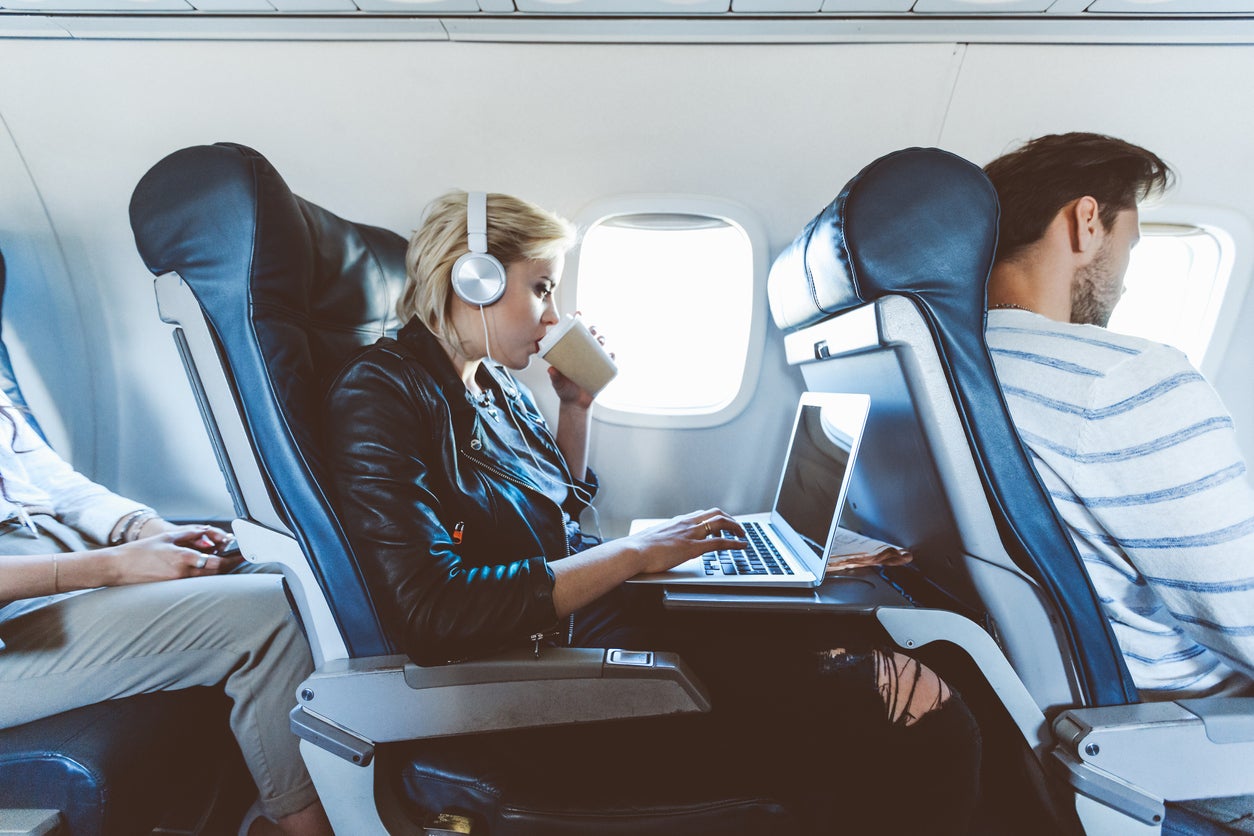In-flight wifi: the dream, the dismal reality and the future
Airlines were so preoccupied with whether or not they could put wifi in the sky, they didn’t stop to think if they should – or, more precisely, if it was any good. As Delta prepares to become the next carrier to roll-out this inflight ‘perk’, Lucy Thackray looks into the future of internet at altitude


I was three hours into a four-and-a-half-hour flight across Europe this summer when I called it. In-flight wifi doesn’t work. Not in a real, impactful way, anyway – not to the point where you can ethically slap a price tag on it and suggest people can get a bit of work done between the seatbelt sign switch-off and the tea trolley.
In my case that price was £7.99 for an “entire flight” wifi pass. That’s £1.77 an hour spent on next to nothing – this in-flight wifi creaked through about 40 minutes of the flight (while we were over land) before disappearing into nothingness and refusing to reconnect. Cabin crew were shruggy at best – and, arguably, it’s not their job to troubleshoot my connectivity issues. They’re busy making sure we’re all alive – or at least caffeinated – and who could argue with that?
Inflight wifi has been a “reality” since around 2006. British Airways, Virgin Atlantic, Emirates, Norwegian and Qatar Airways are just some of the airlines to launch a version of it since then. Some offer free access to business class customers, most charge anything from £2.99 to £20 for a wifi pass. Delta is the next carrier to announce it will be introducing internet at altitude, with plans to launch its free Delta Sync package from as early as 1 February. But 16 years on it remains a hit-and-miss experience.
The problem, says business travel expert John Walton, is that getting wifi on planes is so much more complex than wifi in hotel lobbies, or even on trains. Explaining it to me as though I were a five-year-old (my instructions), Walton tells me how aircraft pick up wifi from two places: from cell towers on the ground – when at lower altitude and closer to land – or from satellites in outer space.
The former is known as air-to-ground (ATG) and is picked up by an aerial on the plane, creating a hotspot to which passengers can connect. For the latter method to work, the aircraft antenna has to be able to reach an orbiting satellite some 20,000 miles from earth. So the signal has to travel much further – hence in-flight wifi often vanishing into thin air as we fly over long stretches of sea, far from the ground towers.
But there are layers of reasons why sky-high wifi seems like a dinosaur – something that should be soundtracked by the bleating of a 1990s modem struggling to dial up. For one, says Walton, every in-flight innovation takes years from creation to becoming available on day-to-day flights.
There are layers of reasons why sky-high wifi seems like a dinosaur – something that should be soundtracked by the bleating of a 1990s modem struggling to dial up
“Aviation has this perennial thing where it’s always lagging consumer technology,” he explains. “It’s a highly regulated industry, because – apparently – people don’t want planes falling out of the sky.
“So you’ve got to develop the technology, certify it, sell it, wait for a plane to be built, have it installed, then eventually have enough of those planes out there to reach critical mass.” All this can take six or seven years to trickle down to us, the passengers.
Emirates’ senior vice president of in-flight entertainment and connectivity, Patrick Brannelly, agrees. “Airlines have to exploit the capabilities of satellites often designed and launched many years ago, and upgrading aircraft equipment to connect to new-generation satellites is very challenging, financially and technically.” However, the airline knows it’s a priority. As Brannelly puts it, “in-flight connectivity is non-negotiable now”.
Furthermore, what we were doing on our phones when that technology was ordered or even installed has changed radically with each passing year it takes until the experience gets to us. TikTok was just a twinkle in a developer’s eye back in 2015, so it’s understandable that the wifi we have now isn’t tailor-made for video streaming.
There are also two types of in-flight wifi, says Walton. Ku band, which started back in 2006, and Ka band, which is more recent. “Ka is faster partly because of the way the radio waves travel, and partly because the people who have the licence to use that spectrum have less competition at the moment,” he says. However, quite a lot of aircraft still have the old Ku-style internet, which feels relatively slow.
You’ve got to develop the technology, certify it, sell it, wait for a plane to be built, have it installed, then eventually have enough of those planes out there to reach critical mass
On top of this, Walton says, airlines routinely “throttle” you on the speed of that wifi, providing a less speedy signal “to make sure you’re not getting more than you’ve paid for”. He mentions one carrier that sells a streaming package, but regularly limits the speed of the wifi on its planes to 1.5 Mbps. “To stream video on anything decent sized, you really need 5 Mpbs,” explains Walton.
(Most airlines mentioned in this story did not respond to enquiries about the limiting of wifi speed. Virgin Atlantic said: “We offer a range of on-board wifi packages to customers, which helps support a fair distribution of the bandwidth and limit the need to run wifi at a lower speed.”)
Okay, so in-flight internet hasn’t necessarily been slow to evolve – we’re just experiencing the innovations from the early and mid-2010s (and airline stinginess). So why don’t airlines warn us that their offering is so clunky?
It isn’t always, says Walton. Wifi quality varies dramatically on different airlines and aircraft, because they use different system providers, fly different routes (alternately well or poorly covered by ground cell towers) and connect to different satellite providers. In the main, US airlines are ahead of the pack when it comes to user-friendliness.
“JetBlue has really good coverage,” says Walton, “because it only flies where there is strong ATG and satellite coverage. Most of the big US airlines have pretty good wifi over the United States, but internationally it’s a bit of a pot-luck thing.”
Conversely, transatlantic routes often suffer because “historically, satellites have been put over land, not water. That’s where the people are,” he points out. “Over remote patches of sea, your only clients are ships, airlines – and the whales.”
But things are undeniably changing in the satellite world: main providers ViaSat and Inmarsat are set to merge after the former agreed to acquire the latter in November 2021. Meanwhile, Elon Musk’s company, SpaceX, has launched Starlink, a venture sending cheaper, smaller, lower-earth-orbit satellites into the atmosphere, and which is aiming to partner with airlines on wifi provision.
The vice-president of Starlink, Jonathan Hofeller, said last year: “Connectivity on aeroplanes is something we think is ripe for an overhaul. The expectation has changed faster than the technology has changed. We’re designing a service where every single passenger on that plane can stream simultaneously.”
Delta has been testing Starlink’s technology in the hope of working with the company, while Hawaiian Airlines has said it is working with SpaceX on a future offering.
In the meantime, Anthony Woodman, vice-president of customer journeys at Virgin Atlantic, agrees that airlines could be clearer when advertising their wifi packages. “There’s always more we can do about managing expectations and letting the customers know what to expect,” he says.
Connectivity on aeroplanes is something we think is ripe for an overhaul. The expectation has changed faster than the technology has changed
“It’s important for customers to know that on some planes you can stream music, and on others it’s more suited to getting emails and staying connected.”
He tells me Virgin will be watching partner airline Delta’s collaboration with Starlink closely as it plans its own next steps in in-flight wifi. However it unfolds, he agrees with Brannelly that connectivity in the sky is a must-have for customers.
“The days of having the cabin door closed and being cut off from civilisation, that’s really changing,” says Woodman.
“People expect to be able to keep browsing, streaming and keeping in touch. Whether it’s watching a sports event or being able to rearrange the second leg of their flight if there’s a delay – that’s the direction air travel is heading in.”
As well as easier streaming, Woodman foresees more of the “internet of things”, where your seat back knows your online identity, offers tailored entertainment choices, remembers your birthday or typical menu choices, counts your air miles and tips cabin crew off about special occasions.
In the meantime, John Walton warns: “Caveat emptor”. Buy a pass on your flight, by all means, but be prepared for a clunky experience if the network provider, satellite and airline throttling stars fail to align.
“From a consumer perspective, it’s still really patchy. It can work well, but we can’t really draw any conclusions about where and when it’s going to be good.”
He recommends purchasing passes with a credit card so you can demand a refund from your card provider if the service doesn’t work as advertised.
“Most importantly, if it’s poor you should absolutely ask for your money back. That’s the only way the airline is going to take notice and improve things.”
Join our commenting forum
Join thought-provoking conversations, follow other Independent readers and see their replies
Comments